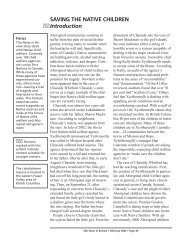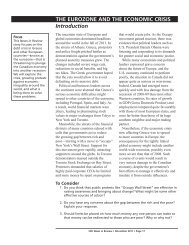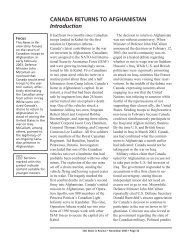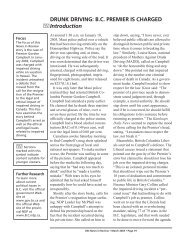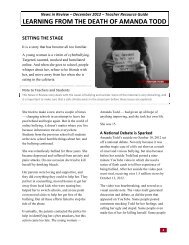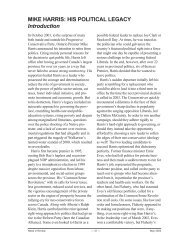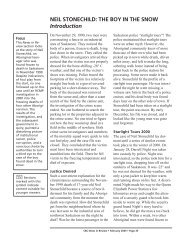TATTOOS: AN ANCIENT ART GOES ... - News in review
TATTOOS: AN ANCIENT ART GOES ... - News in review
TATTOOS: AN ANCIENT ART GOES ... - News in review
You also want an ePaper? Increase the reach of your titles
YUMPU automatically turns print PDFs into web optimized ePapers that Google loves.
Did you know . . .<br />
Humans are the<br />
only creatures on<br />
the planet to<br />
decorate themselves?<br />
Why do you<br />
th<strong>in</strong>k this is so?<br />
Warn<strong>in</strong>g!<br />
Pierc<strong>in</strong>gs are not<br />
always safe. Infections<br />
<strong>in</strong> ear cartilage<br />
can be hard to<br />
heal because the<br />
area gets so little<br />
blood that antibiotics<br />
cannot reach the<br />
site. Tongue<br />
pierc<strong>in</strong>gs cause<br />
chipped teeth,<br />
numb tongues, and<br />
speech impediments.<br />
And there’s<br />
always the risk of<br />
r<strong>in</strong>gs catch<strong>in</strong>g on<br />
someth<strong>in</strong>g and<br />
tear<strong>in</strong>g flesh.<br />
YV<br />
<strong>TATTOOS</strong>: <strong>AN</strong> <strong>AN</strong>CIENT <strong>ART</strong> <strong>GOES</strong> MAINSTREAM<br />
A Short History of Body Art<br />
The adult body has about 1.4 to 1.9<br />
square metres of “canvas.” Some<br />
people may choose to keep their canvases<br />
clean. But others, from all walks<br />
of life, from all cultures, and from every<br />
period of history, have transformed<br />
their bodies. For many, the change is<br />
practical—humans must wear cloth<strong>in</strong>g<br />
<strong>in</strong> cold climates. But we have also used<br />
cloth<strong>in</strong>g to say someth<strong>in</strong>g about ourselves.<br />
Most people enjoy wear<strong>in</strong>g<br />
cloth<strong>in</strong>g that makes them look good.<br />
But our desire to transform our<br />
appearance goes further than our cover<strong>in</strong>gs—much<br />
further. Even before we<br />
began wear<strong>in</strong>g clothes, we decorated<br />
our bodies with pa<strong>in</strong>ts. Prehistoric rock<br />
draw<strong>in</strong>gs show bodies decorated with<br />
mark<strong>in</strong>gs. Then there are the permanent<br />
transformations. Just consider the<br />
follow<strong>in</strong>g examples of body art techniques<br />
used <strong>in</strong> various cultures at<br />
different times <strong>in</strong> history:<br />
• wear<strong>in</strong>g makeup (ancient Egyptians<br />
used kohl to circle their eyes)<br />
• wear<strong>in</strong>g body and facial pa<strong>in</strong>t (First<br />
Nations prepared this way for battle)<br />
• pierc<strong>in</strong>g with bone or metal<br />
• scarification or brand<strong>in</strong>g (creat<strong>in</strong>g<br />
raised scars by burn<strong>in</strong>g or cutt<strong>in</strong>g)<br />
• stretch<strong>in</strong>g flesh over disks (ear lobes,<br />
lower lips)<br />
• extend<strong>in</strong>g necks (with brass r<strong>in</strong>gs,<br />
among the Paduang people of<br />
Myanmar)<br />
• deform<strong>in</strong>g bones (foot-b<strong>in</strong>d<strong>in</strong>g <strong>in</strong><br />
Ch<strong>in</strong>a; flattened foreheads among the<br />
Ch<strong>in</strong>ook Nation)<br />
• squeez<strong>in</strong>g waists with corsets (Europe)<br />
CBC <strong>News</strong> <strong>in</strong> Review • April 2005 • Page 48<br />
• twist<strong>in</strong>g hair <strong>in</strong>to dreadlocks (orig<strong>in</strong>at<strong>in</strong>g<br />
with the Masai <strong>in</strong> Kenya; embraced<br />
by Rastafarians <strong>in</strong> Jamaica)<br />
• implants and reductions<br />
• liposuction, lifts, and tucks<br />
In modern Canadian society, it is very<br />
common to cut and style hair, shave<br />
faces and legs, and put on makeup. Do<br />
these practices seem “normal” to you?<br />
In many cultures, they are not. “Normal”<br />
varies from culture to culture and<br />
society to society. In Maori society, red<br />
lips were considered ugly, so women<br />
tattooed their lips blue. Beauty also<br />
changes over time.<br />
Let’s look at two forms of body art<br />
that are becom<strong>in</strong>g more common <strong>in</strong><br />
ma<strong>in</strong>stream Canadian society: body<br />
pierc<strong>in</strong>g and henna tattoos.<br />
Pierc<strong>in</strong>g<br />
A popular fashion trend creat<strong>in</strong>g some<br />
controversy is pierc<strong>in</strong>g. We pierce our<br />
earlobes, ear cartilage, and eyebrows.<br />
We pierce our lips, noses, and tongues.<br />
We pierce our navels, nipples, and<br />
genitals. If it’s covered <strong>in</strong> sk<strong>in</strong>, someone<br />
has pierced it.<br />
Over the space of two decades,<br />
pierc<strong>in</strong>g has become common. Not only<br />
kids but also young professionals sport<br />
unusual pierc<strong>in</strong>gs. Although many<br />
companies have a “no visible pierc<strong>in</strong>gs”<br />
rule, some professions are a little more<br />
accept<strong>in</strong>g. One young high school<br />
English teacher sports a variety of<br />
pierc<strong>in</strong>gs on her face. Luckily, the<br />
southern Ontario school where she<br />
teaches allows her to do this. The<br />
students she teaches th<strong>in</strong>k she’s cool for<br />
hav<strong>in</strong>g them. So the pierc<strong>in</strong>gs may<br />
actually help her do her job.




